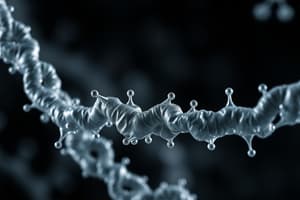Podcast
Questions and Answers
Which biomolecule category primarily functions in energy storage and cellular structure?
Which biomolecule category primarily functions in energy storage and cellular structure?
- Lipids (correct)
- Nucleic Acids
- Carbohydrates (correct)
- Proteins
What structure level of proteins refers to the sequence of amino acids?
What structure level of proteins refers to the sequence of amino acids?
- Secondary
- Tertiary
- Primary (correct)
- Quaternary
Which of the following types of biomolecules are NOT primarily composed of carbon, hydrogen, and oxygen?
Which of the following types of biomolecules are NOT primarily composed of carbon, hydrogen, and oxygen?
- Lipids
- Proteins (correct)
- Nucleic Acids (correct)
- Carbohydrates
Which type of carbohydrate is formed from two monosaccharides?
Which type of carbohydrate is formed from two monosaccharides?
What is the characteristic structure of DNA?
What is the characteristic structure of DNA?
What term describes the large biomolecules formed from smaller units?
What term describes the large biomolecules formed from smaller units?
Which biomolecule acts as a catalyst to speed up chemical reactions?
Which biomolecule acts as a catalyst to speed up chemical reactions?
What type of lipid is a key component of cell membranes?
What type of lipid is a key component of cell membranes?
Flashcards are hidden until you start studying
Study Notes
Overview of Biomolecules
- Biomolecules are organic molecules that are essential for life.
- They are primarily classified into four major categories: carbohydrates, lipids, proteins, and nucleic acids.
1. Carbohydrates
- Composed of carbon, hydrogen, and oxygen (C, H, O).
- Function as energy sources and structural components.
- Types:
- Monosaccharides: Simple sugars (e.g., glucose, fructose).
- Disaccharides: Formed by two monosaccharides (e.g., sucrose, lactose).
- Polysaccharides: Long chains of monosaccharides (e.g., starch, glycogen, cellulose).
2. Lipids
- Composed mainly of carbon and hydrogen.
- Hydrophobic and insoluble in water.
- Functions include energy storage, membrane structure, and signaling.
- Types:
- Fats and oils: triglycerides (glycerol + fatty acids).
- Phospholipids: component of cell membranes (hydrophilic head and hydrophobic tails).
- Steroids: signaling molecules (e.g., cholesterol, hormones).
3. Proteins
- Composed of amino acids linked by peptide bonds; contain C, H, O, nitrogen (N).
- Serve diverse functions such as catalysts (enzymes), structural support, transport, and signaling.
- Structure levels:
- Primary: Amino acid sequence.
- Secondary: Alpha helices and beta sheets.
- Tertiary: 3D folding.
- Quaternary: Assembly of multiple polypeptides.
4. Nucleic Acids
- Composed of nucleotides (phosphate group, sugar, nitrogenous base).
- Function in genetic information storage and transmission.
- Types:
- DNA (Deoxyribonucleic Acid): Double-helix structure; stores genetic information.
- RNA (Ribonucleic Acid): Single-stranded; involved in protein synthesis and gene regulation.
Key Concepts
- Macromolecules: Large biomolecules formed from smaller units (e.g., polysaccharides from monosaccharides).
- Enzymes: Proteins that act as biological catalysts to speed up chemical reactions.
- Hydrophilic vs. Hydrophobic: Hydrophilic molecules interact with water while hydrophobic molecules do not.
- Metabolism: The total of all chemical reactions in an organism, often involving biomolecules.
Functions in Living Organisms
- Energy Storage and Supply: Carbohydrates and lipids provide energy.
- Structural Component: Proteins and carbohydrates play a role in cellular structure.
- Genetic Information: Nucleic acids store and transmit genetic information for inheritance and function.
- Catalysis: Enzymes reduce activation energy, facilitating metabolic reactions.
Biomolecules Overview
- Essential organic molecules for life
- Four primary categories: carbohydrates, lipids, proteins, and nucleic acids
Carbohydrates
- Composed of carbon, hydrogen, and oxygen
- Function as energy sources and structural components
- Monosaccharides: simple sugars (e.g., glucose, fructose)
- Disaccharides: two monosaccharides joined (e.g., sucrose, lactose)
- Polysaccharides: long chains of monosaccharides (e.g., starch, glycogen, cellulose)
Lipids
- Primarily carbon and hydrogen
- Hydrophobic and insoluble in water
- Functions include energy storage, membrane structure, and signaling
- Fats and oils: triglycerides (glycerol + fatty acids)
- Phospholipids: components of cell membranes (hydrophilic head and hydrophobic tails)
- Steroids: signaling molecules (e.g., cholesterol, hormones)
Proteins
- Composed of amino acids linked by peptide bonds; contain carbon, hydrogen, oxygen, and nitrogen
- Diverse functions: catalysts (enzymes), structural support, transport, and signaling
- Structure levels:
- Primary: amino acid sequence
- Secondary: alpha helices and beta sheets
- Tertiary: 3D folding
- Quaternary: assembly of multiple polypeptides
Nucleic Acids
- Composed of nucleotides (phosphate group, sugar, nitrogenous base)
- Function: genetic information storage and transmission
- DNA (deoxyribonucleic acid): double-helix structure, stores genetic information
- RNA (ribonucleic acid): single-stranded, involved in protein synthesis and gene regulation
Key Concepts
- Macromolecules: large biomolecules formed from smaller units (e.g., polysaccharides from monosaccharides)
- Enzymes: proteins that act as biological catalysts to speed up chemical reactions
- Hydrophilic: molecules interact with water
- Hydrophobic: molecules do not interact with water
- Metabolism: all chemical reactions in an organism, often involving biomolecules
Functions in Living Organisms
- Energy storage and supply: carbohydrates and lipids
- Structural components: proteins and carbohydrates
- Genetic information: nucleic acids
- Catalysis: enzymes facilitate metabolic reactions
Studying That Suits You
Use AI to generate personalized quizzes and flashcards to suit your learning preferences.




